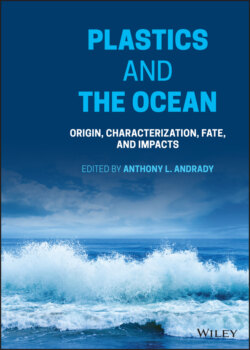Читать книгу Plastics and the Ocean - Группа авторов - Страница 39
2.1 Function of Plastic Additive Classes
ОглавлениеThe ecological and toxicological effects of plastic in the marine environment are generally discussed or modeled as if they were “pure” polymers (Cole et al. 2015; Kaiser et al. 2019; Yin et al. 2018); yet, no plastic that exists in the waste stream today is manufactured without additives or as a “barefoot” formulation. Every piece of plastic is made up of a unique combination of the host polymer, with some residual monomers or catalysts, as well as chemical additives added during processing of the plastic (Hahladakis et al. 2018; Hermabessiere et al. 2017). A staggering amount of different kinds of additives are used in plastic formulations and each of them plays a distinct role in delivering/enhancing the functional properties, performance, or appearance of a plastic product (Marturano et al. 2016). Depending on the formulation, plastics may contain anywhere from <1 to 50% or more by weight of plasticizers (Chaudhary et al. 2016; Marturano et al. 2016). Typically, plasticizers, fillers, and flame retardants (FRs) are used at high weight fractions in plastic formulations and, therefore, account for about three‐quarters of all additives produced. Other additives, such as antioxidants and light stabilizers, are used at much lower loadings. Despite the popular conception that plastics last forever, they are organic materials that undergo significant degradation when exposed to processing or environmental conditions, including high temperatures, ultraviolet (UV) radiation, oxygen in the atmosphere, and water (see Chapter 8). The durability and performance that is expected from thermoplastics would not be possible without these intentionally added chemical compounds. The production and use of plastics (and, therefore, plastic additives) has continued to increase exponentially since the mid‐20th century (Binetti et al. 2008). If current production rates continue, a total of 2000 million metric tons of additives will have been produced by the end of 2050 (Geyer et al. 2017). This is based on an estimate of plastics containing on average 7% additives by mass (Geyer et al. 2017). It has been estimated that at least 190 metric tons of additive chemicals entered the ocean in 2015 alone, a rate that is expected to double by 2025 (De Frond et al. 2019). The decades’ worth of plastics already in the ocean was formulated without consideration for marine disposal.
This chapter aims to introduce plastic additives with a focus on their chemistry and function, transport and fate, detection in marine environments, and toxicities. The extensive list of additives can be simplified by dividing the types of additives into three groups: functional additives, colorants, and fillers/reinforcements. The most common types of additives used are outlined in Table 2.1 along with typical loadings in the polymer, percent share in global plastics production, market sizes, key examples, and desired effects.
Table 2.1 Classes of plastic additives, typical loadings, and percent share in plastics production.
Source: “Typical loadings” are the max and min ranges reported by Geyer et al. 2017, Zweifel et al. (2001), Hahladakis et al. (2018), Andrady and Rajapaske (2019), and Ambrogi et al. (2017).
| Type | Additive Class | Typical loadings (wt%) | Share (%) | Market size (USD million)a | Examples | Purpose |
|---|---|---|---|---|---|---|
| Plasticizers | Functional | 10–70 | 34 | 1550 | Phthalates, tris(2‐chloroethyl) phosphate | Soften polymer and make more flexible |
| Flame retardants | Functional | 3–25 | 13 | 7000 | Poly(bromo diphenyl ethers), organophosphorus | Prevent ignition or flame propagation |
| Antioxidants | Functional | 0.05–3 | 6 | 5770 | Hindered phenols, alkylphenolsb, phosphitesc, lactones, hydroxylamines | To prevent discoloration and degradation during processing, use, and weathering |
| Heat stabilizers | Functional | 0.1–8 | 5 | 3630 | Dialkyl maleates or laureates and dialkyl mercaptides of tin in PVC formulations to retard HCl evolution during processing | To prevent thermal degradation during processing |
| Fillers | Fillers | 1–50 | 28 | 10 000 | Clays, silica, glass, chalk, talc, asbestos, alumina, rutile, carbon black, carbon nanotubes | To provide mechanical reinforcement or formulation cost reductions |
| Impact modifiers | Functional | 0.5–30 | 5 | 3280 | Acrylonitrile butadiene styrene (ABS), acrylonitrile styrene acrylate (ASA) | To increase flexibility and impact strength to meet physical property requirements of rigid parts |
| Colorants | Colorants | 0.25–5 | 2 | 37 000 | Cadmium, chromium, lead, and cobalt compounds, titanium dioxide, carbon black; organic dyes | To impart a desired color on the finished product |
| Lubricants | Functional | 0.1–3 | 2 | 4558 | Waxes, oils, long‐chain esters of polymeric alcohols | Allows easier processing of the plastic (i.e., lower temperatures, faster processing times) |
| Light stabilizers | Functional | 0.05–3 | 1 | 373 | Hindered amine light stabilizers, benzo‐phenone light‐absorbing compounds | To prevent degradation of the plastic upon exposure to light sources |
| Other (anti‐static, anti‐microbial, etc.) | — | — | 4 | — | Silver, thiabendazole, aliphatic amines | — |
| Monomers, catalysts | Unintended Additives | — | — | — | Bisphenol‐A, styrene, antimony | Unreacted monomers or residual catalyst left over from the polymer synthesis |
a These are market sizes for all applications, not just in plastics.
b The majority of alkylphenols (APs) found in the environment are degradation products of surfactants, not plastic additives.
c If phosphites are used, the loadings can be higher than the range indicated.
